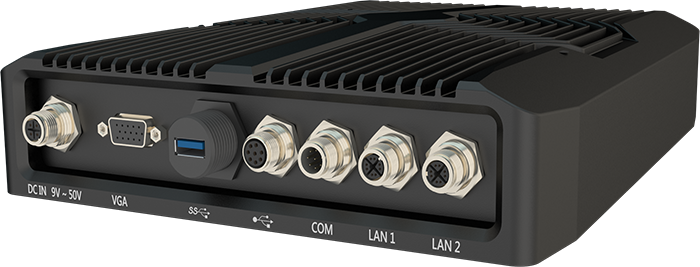AI Edge Inference Computer
The AI Edge Inference Computer exploits NVMe’s rapid efficiency and storage scalability for dynamic, hyperintelligent IoT deployments. Four hot-swappable NVMe trays offer the reflexive data support for complex AI and machine learning applications. The first-of-its-kind solution grants data immediacy to maximize GPU throughput for more holistic AI and machine learning in trying industrial settings
Fast Response Time
Reduce Network Traffic
Less Cloud Reliance
Accelerate Control Time
Lower Cost
More Secure
Machine Vision Computer

Machine Vision Computers are designed for machine vision learning and industrial factory automation. Each models come with a variety of expansion slots, up to a maximum of five PCIe and PCI slots mixed.
Factory Automation
Machine Vision
Military And Defense
Motion Control
Digital Surveillance
In-Vehicle Fanless Computer
In-vehicle fanless computers are built for edge computing applications needing to integrate with the CAN bus sensor network of a transport vehicle. Specifically designed for in-vehicle applications, these edge computers feature high shock and vibration resistance, lockable M12 connectors and power ignition management.
Autonomous Vehicles
Machine Learning
Digital Surveillance
IoT Connectivity
Mass Transportation
According to Gartner, a leading IT research company "estimates that by 2025, 75% of data will be processed outside the centralized data center or cloud."


What is an Edge Computer?
A edge computer is a computing platform physically located at or near the source of data generation. Compared to the traditional cloud computing, edge computers benefits business operations with faster and more efficient services by processing data on-site without having to send it through the cloud network. This results in real-time decision making and less bandwidth latency for time-sensitive applications. As edge computing expands into more challenging environments, it is necessary to ruggedize the system for successful deployments. Rugged edge computers are key factors in enabling future technologies in industrial automation, smart cities, healthcare, natural resources, defense and telecommunications. Learn more about Edge Computing
What Are Some Type of Edge Computers?
Premio designs and manufactures a variety of custom, highly-reliable world-class edge computers for enterprises with highly specialized requirements. The different types of edge computer systems that we design and manufacture include air-cooled edge computers, fanless industrial edge computers, as well as rugged, fanless industrial computers.
5 Key Features Of Edge Computing

1
Wireless Connectivity
Access to Wifi, 4G LTE, Bluetooth and future 5G networks including GPS/GNSS location tracking allows more flexibility and possibilities for devices to gather important data points for new IoT Technologies

2
Mobility and Remote Deployment
Capability to be deployed in various mobile and remote locations decentralized from resources in the cloud.

3
Performance Accelerators
Increase in processor performance, GPU based inference analysis, and large capacity data drives to manage local analytics without having to move data over the network to the cloud

4
Variety of I/O Ports and PCIe and PCI Expansion Slots
Capability to connect to various legacy and modern devices for data gathering in analog and digital IoT signals.

5
Ruggedness and Hardware Security
Protections against environmental elements and factors that are harmful to sensitive computer components. Edge computers feature fanless designs, wide operating temperatures, wide voltage input ranges and high shock and vibration resistance
FAQ
A rugged edge computer is a fanless industrial grade computer that brings computation and data storage physically closer to where an application is operating in harsh usage conditions. Local IoT sensors and devices can process data through local edge computers for faster response times with lower latency instead of sending it to a distant cloud data center for off-site processing. Rugged edge computers are fortified and proven to operate reliably in extreme environments where typical computers are guaranteed to fail due to either severe hot or cold temperatures, dust or debris, humidity, widely varying voltage sources, and shock or vibration. With a higher MTBF (mean time between failure), rugged edge computers provide reliable mission critical operation for industrial IoT application systems.
Wireless Connectivity
Access to wireless data communications in Bluetooth, Wifi, cellular 4G LTE and future technologies enable rugged edge computers to integrate into modern infrastructures as the number of wireless sensors and devices grow exponentially. Industries needing machine-to-machine communication, real-time data monitoring, GPS/GNSS location tracking and autonomous systems benefit from utilizing wireless technology in edge computers.
Mobility and Remote Deployment
Rugged edge computers are designed with small form factors and rugged qualities for mobile and remote integration where applications often have space fitting constraints and harsh operating conditions. In addition, rugged edge computers feature watchdog system monitoring functions to minimize detrimental downtime out in the field due to the lack of on-site technical support.
Performance Accelerators
An increase in compute capabilities is a major driving force for rugged edge computing. Performance accelerators in the form of more powerful microchips (CPU, GPU, VPU) and faster storage drives empower IoT applications with real-time local processing through an edge computer instead of relying on the cloud for off-site computation.
Variety of I/O Ports and Expandability
The flexibility of rugged edge computers to interconnect with a wide variety of legacy and modern devices, controllers or machinery allows it to capture valuable data insights for actionable results. These ports include COM, USB, GPIO/Digital I/O, LAN/PoE, and expansion ports in PCI/mini-PCIe/PCIe.
Ruggedness and Hardware Security
What sets a rugged edge computer apart is its durability to operate in harsh environments with 24/7 mission critical reliability. Purpose-built for rugged deployments means a true fanless design, wide operating temperatures, wide voltage inputs, and shock and vibration resistance. In addition to strengthened rugged qualities, cryptographic security is essential to protect the digital data communications between devices from external attacks.
- Smart Surveillance for Transportation Services
- Data Monitoring in Extreme Environments
- High-Density IoT Gateways
- Industrial and Manufacturing Automation
- Smart Agriculture
- Autonomous Navigation and Robotics
- Solar Grid Control and Communication
- Data Acquisition for Predictive Maintenance
- Intelligent Traffic Systems and Management
Real-time Processing and Analysis
IoT applications utilize rugged edge computing to process and analyze data with faster response times and low latency due to its physical proximity.
Security
Large single attacks on data centers can wreak havoc on the wealth of private data information stored in its servers. But the distributed paradigm of edge computing is able to mitigate overall damage with sufficient security measures in place.
Deployment Flexibility
The scalability and versatility of rugged edge computers make it easier for business to integrate into their operations. The improvements of compute, storage, and analytics in a smaller footprint allows rugged edge computers to implement in a variety of spaces near the data source.
Reliability
Rugged edge computers are durable enough to provide mission critical reliability for continuous operation and are also capable of working without cloud servers.
Business Cost Savings
By leveraging the local processing at the edge, business operations don’t have to rely on sending data over networks to the cloud thus saving costs on bandwidth and data management.
Compared to current edge computing models, rugged edge computers offer added durability and rugged features to excel in extreme environments. Some edge computing models consist of mini-data centers that feature a significant increase in processing performance but aren’t able to be remotely deployed in mobile environments where rugged edge computers can be integrated.
The capabilities of edge computing solutions range from basic event filtering to complex-event processing or batch processing.
Rugged edge computers hold several advantages of typical embedded computers including its tough rugged features, increased processing performance, and wider connectivity for device communication.
Rugged edge computer excel in mobile and remote deployments by leveraging specialized software such as Windows 10 IoT with fixed purpose device features to improve usability such as long-term servicing channels to eliminate inconsequential updates from interrupting edge applications.
Edge computing is used for analyzing data that is generated from sensors and devices to produce insights or actionable results in a local environment without needing to leverage the cloud for processing. This provides real-time responses with reduced latency for time-sensitive applications such as autonomous navigation. Additionally, edge computing offers better efficiency by processing large datasets locally and packaging it before transmitting to the cloud to save on network traffic and bandwidth.







